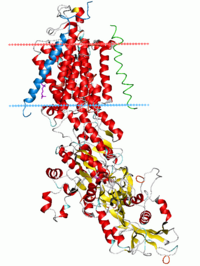
Photo from wikipedia
Although effects of potassium (K) on cotton growth have been explored extensively, the effects of K deficiency on the physiological changes closely related to cotton fiber development are lacking. Thus,… Click to show full abstract
Although effects of potassium (K) on cotton growth have been explored extensively, the effects of K deficiency on the physiological changes closely related to cotton fiber development are lacking. Thus, a 2-year field experiment was conducted with two cotton cultivars (Simian 3 and Siza 3) under 0 kg K2O ha−1 (K deficiency) and 300 kg K2O ha−1 (K sufficiency). The results showed that tonoplast adenosine triphosphatase (V-ATPase), pyrophosphatase (PPase), plasma membrane H+-ATPase (PM H+-ATPase), phosphoenolpyruvate carboxylase (PEPC), sucrose synthesis (SuSy) and vacuolar invertase (V-INV) were highly sensitive to K deficiency. The decreases in those enzymes resulted in low malate and soluble sugar contents, which together with low K concentration declined the driving force for fiber elongation, leading to significantly lower fiber length in the 0 kg K2O ha−1 treatment. The activity of sucrose phosphate synthase (SPS) was obviously increased by K deficiency before 20 days post anthesis (DPA), which could partly explain the acceleration of fiber cellulose synthesis and the increase in fiber strength in the 0 kg K2O ha−1 treatment in the early stage. However, SPS activity was decreased by K deficiency after 20 DPA and SuSy activity was reduced by K deficiency at any sampling date, resulting in low fiber strength in the end. Compared with Simian 3, the enzymes V-ATPase, PPase, PM H+-ATPase, PEPC and SuSy during fiber elongation stage were more sensitive to K deficiency in Siza 3, and the enzymes SuSy and SPS during fiber-thickening stage were more sensitive to K deficiency in Siza 3, which were the important reasons causing greater decreases in final fiber length and final fiber strength for Siza 3 than Simian 3 under K deficiency.
Journal Title: Acta Physiologiae Plantarum
Year Published: 2018
Link to full text (if available)
Share on Social Media: Sign Up to like & get
recommendations!